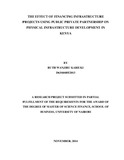| dc.description.abstract | Many emerging markets and most low-income countries require a major step increase in infrastructure investment to alleviate growth constraints, respond to urbanization pressures and meet their crucial goals for inclusive growth, development, and sustainability. This project therefore determined effect of financing infrastructure projects under public private partnership on the level of physical infrastructure in Kenya. To achieve this objective, the study used a descriptive survey and the population for this study included all the physical infrastructure projects conducted in Kenya. The estimated number of physical infrastructure projects carried out in Kenya for the last ten years is more than 15,000.The study conducted a cluster sampling of 60 infrastructure projects from the listed obtained from PPP unit and Medium term expenditure framework report, 2013. This was followed by a systematic selection of 30 infrastructure projects from each of the clustered list under public private partnership and the other physical infrastructure projects. The study used secondary data which was obtained from a number of sources namely: audited financial statements from The National Treasury, PPP unit and Medium term expenditure framework reports. Secondary data was reviewed for a period of ten years (2004-2013) depending on data availability and accessibility. The study used 40 points (forty quarters in a period often years). Data was analyzed with the help of a multiple regression model. Infrastructure projects was the independent variable which was measured using the value of each investment in PPPs, expressed as a percent of GDP and infrastructure development was the dependent variable which was measured using the number of projects expressed as a percentage of GDP. The results of the regression analysis showed that there was a direct relationship. 42% was explained by the variables under the study. This meant that the regression model used was a good predictor since the variables contributed 65% of the relationship between the independent and dependent variables in the regression model. The study therefore concluded that financing infrastructure projects under public private partnership is critical since infrastructural development highly contributes to aggregate economic performance because many policy decisions for example assessing the growth effects of fiscal interventions in the form of public investment changes, or to assess if public infrastructure investments can be self-financing is generally accepted, economic infrastructure is vital for economic growth and poverty reduction since it plays a key role in enhancing competitiveness, facilitating trade and integrating countries to the rest of the world. The study therefore recommended that the government should Deepen Domestic Financial Market through Lengthening the Government yield curve and developing more liquid Government bond market. The study further recommends the need for developing a regulatory regime for securitization of instruments to enable participation of pension funds and insurance companies. The major limitation of the study was that the study limited itself to a sample of 60 projects only while the estimated number of physical infrastructure projects carried out in Kenya for the last ten years is more than 15,000 | en_US |

